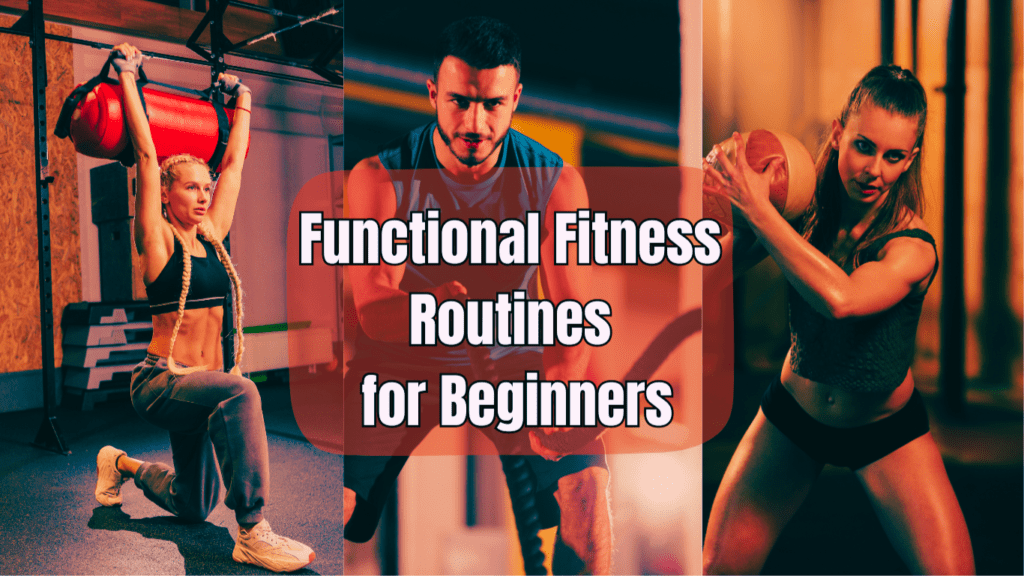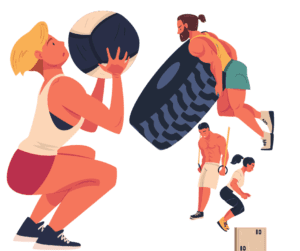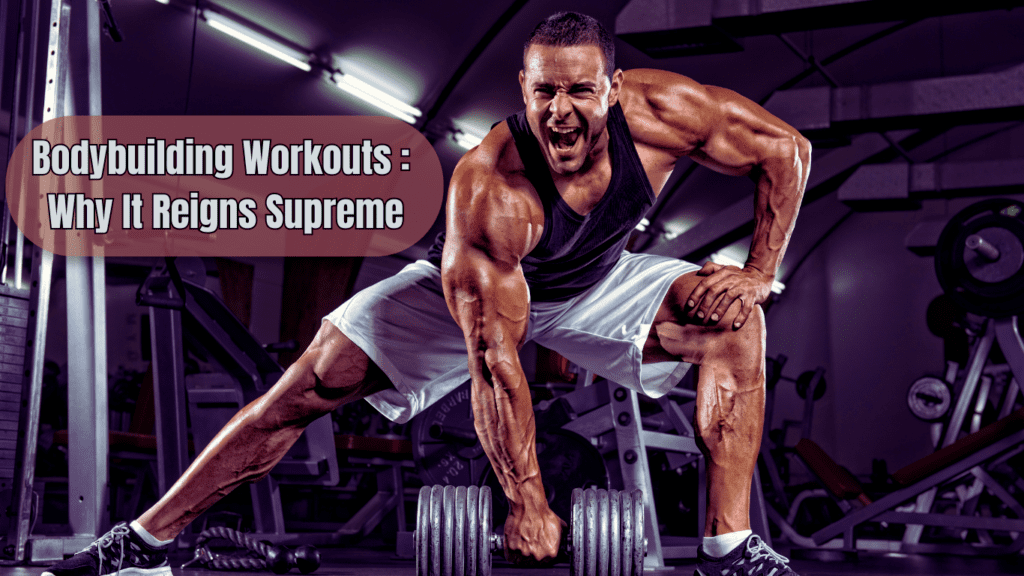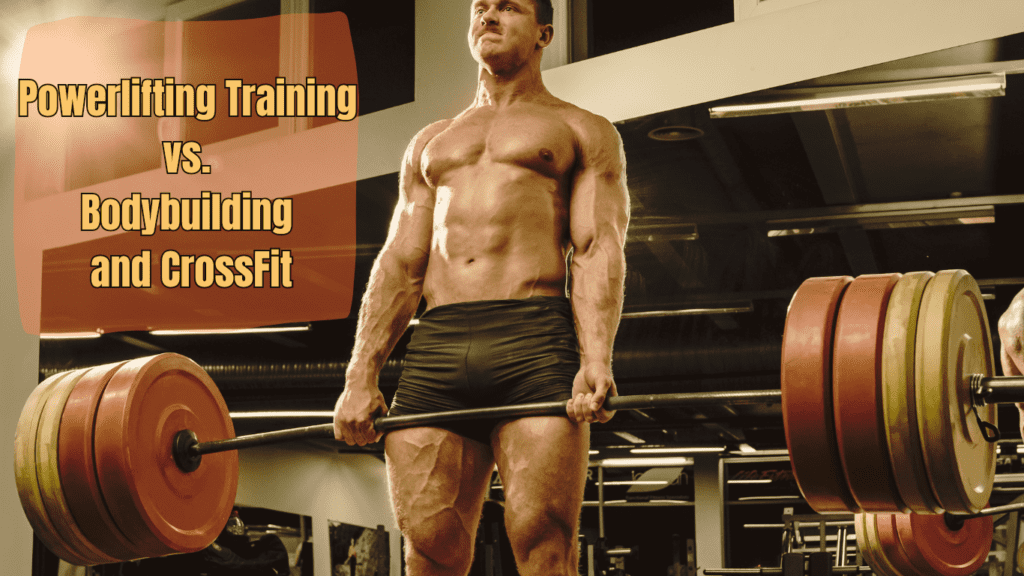Functional Fitness Routines for Beginners: A Holistic Approach to Your Fitness Journey
“Functional fitness routines for beginners” offer a refreshing entry point into the fitness journey for those taking their initial steps into the world of workouts. Embarking on a fitness journey as a beginner can feel like stepping into a maze of options, but fear not! Welcome to the world of “Functional fitness routines for beginners.” It might sound like just another fitness buzzword, but let me assure you, it’s more than a passing trend—it’s a transformative approach to wellness.
So, what is functional fitness, and why should beginners like you consider it as the cornerstone of their fitness routine? Well, let’s unravel this in a way that won’t leave you scratching your head with complex terminology.

Functional fitness is all about optimizing your everyday movements for efficiency and effectiveness. It goes beyond the surface-level goals of looking good or lifting heavy weights; it’s about being functionally fit for the demands of your daily life. Imagine effortlessly lugging your groceries, playing with your kids, or conquering that flight of stairs without breaking a sweat. That’s the essence of functional fitness—it’s not just about workouts; it’s about fitness for real-life scenarios.
Subscribe And Get Our Free E-Book:Unlocking The Power Of Nutrition-Supplements, Substitutes, and Superfoods!
Now, you might be wondering how functional exercise differs from other workout styles. Let’s take a quick peek, shall we? Traditional gym workouts, while fantastic for building specific muscle groups, might not seamlessly translate into practical, real-world activities. On the flip side, high-intensity interval training (HIIT) is excellent for calorie burning but may not address overall functional strength.
Bodyweight workouts, another popular choice, build a solid foundation but might lack the dynamic range of motion that functional exercises provide. Functional fitness, however, marries the best of all these worlds. It targets multiple muscle groups, enhances flexibility, and improves overall coordination, making it a comprehensive approach to fitness.
Now, who is functional fitness for? The answer: everyone! Whether you’re a gym novice or a seasoned fitness enthusiast, functional fitness routines for beginners are adaptable to all fitness levels. It’s not about outdoing others; it’s about challenging yourself and becoming the best version of you.
But can you genuinely see progress with functional fitness? Absolutely. Unlike some fitness programs that focus solely on aesthetics, functional fitness brings tangible improvements to your daily life. Increased stamina, improved posture, and enhanced stability are just a few perks that contribute to a better, more functional you.
And let’s address the burning question: Can you achieve that Instagram-worthy physique with functional fitness? The answer might surprise you. While traditional gym workouts often emphasize isolated muscle building, functional fitness enhances your overall body composition. Yes, you can achieve a great visible shape and beyond with functional fitness. It’s not just about the muscles you see; it’s about the muscles that support and power your entire body.
So, dear beginner, as you embark on your fitness journey, consider making our Functional fitness routines for beginners guide your mantra. It’s not just a workout; it’s a lifestyle that extends beyond the walls of the gym. Get ready to embrace a fitness routine that not only enhances your appearance but also empowers you to tackle the challenges of everyday life. Stay tuned for more tips, tricks, and workouts as we delve deeper into the world of functional fitness for beginners. Cheers to a fitter, more fabulous you!

Comparison of Workout Styles: Traditional vs. HIIT vs. Functional Fitness
| Aspect | Traditional Gym Workouts | High-Intensity Interval Training (HIIT) | Functional Fitness |
|---|---|---|---|
| Focus | Specific muscle groups | Calorie burning, cardiovascular | Everyday movements, overall fitness |
| Key Objective | Muscle hypertrophy | Fat loss, endurance | Improving functional strength, mobility |
| Exercise Types | Isolation exercises | Compound movements, cardio bursts | Dynamic, multi-joint movements |
| Real-Life Application | Limited transfer to daily tasks | Limited transfer to daily tasks | Directly applicable to daily movements |
| Flexibility and Mobility | Often neglected | May incorporate some flexibility work | Emphasizes flexibility and mobility |
| Coordination and Balance | Secondary focus | May include agility drills | Integral part of training |
| Adaptability to Fitness Levels | May require modifications | Adaptable but intense | Adaptable to all fitness levels |
| Injury Prevention | Variable depending on form | Risk of overuse injuries | Focuses on proper form, prevents imbalances |
| Time Efficiency | Time-consuming | Short bursts of high-intensity effort | Efficient, whole-body workouts |
| Aesthetic Focus | Emphasizes muscle aesthetics | May contribute to lean physique | Enhances overall body composition |
| Long-Term Sustainability | May lead to muscle imbalances | Sustainable but high impact | Promotes balanced strength and mobility |
A Beginner’s Guide to Fun and Effective Workouts
We’re about to embark on the second part of our fitness journey, and once again, we’re diving into the world of our Functional fitness routines for beginners guide. So, let’s jump into the excitement of functional fitness and explore 20 fantastic exercises that will set you on the path to a fitter, healthier you!
Functional fitness isn’t just about working out for the sake of it; it’s about making your daily movements more efficient and effective. It’s a game-changer for beginners, offering a holistic approach to wellness. You’re not just getting fit; you’re getting fit for real life!
Now, let’s get down to the nitty-gritty – the exercises! Here’s a curated list of 20 functional fitness exercises for beginners that you can do at home, outside, or at the gym. Get ready for some muscle activation and a whole lot of fun!
1. Bodyweight Squats: Imagine you’re about to sit in an invisible chair. Stand shoulder-width apart, chest up, and lower your body down. Keep those knees from going past your toes.
2. Push-Ups: A classic but effective move. Maintain a plank position, lower your body by bending those elbows, then push right on back up. Watch that lower back – we don’t want any sagging.
3. Plank: Think of yourself as a straight line from your head to your heels. Engage that core and hold it steady. No dropping those hips!
4. Lunges: Step forward with one leg, bend those knees at a 90-degree angle. Keep it smooth, and watch that front knee – don’t let it sneak past your toes.
5. Bent-Over Rows: Time for some upper back and biceps action. Hinge at your hips, pull those dumbbells towards your chest, and give those shoulder blades a good squeeze. Oh, and keep that back straight!
6. Deadlifts: Hinge at your hips, lift those weights, but please, keep that back straight. No rounding allowed!
7. Kettlebell Swings: Swing it between your legs, then give it all you’ve got, driving those hips forward. Remember, it’s about the hips, not the arms!
8. Mountain Climbers: Get into plank position and bring those knees towards your chest, one at a time. Quick and efficient – no hunching allowed.
9. Step-Ups: Find a raised platform, step onto it, and drive through that heel. But hey, no leaning forward too much!
10. Russian Twists: Time for some oblique action. Sit on the floor, lean back a bit, and start rotating that torso. Touch the floor on each side. Feel the burn!
11. Box Jumps: Stand in front of a sturdy box, jump onto it, then step back down. It’s fantastic for explosive power and targeting your lower body muscles.
12. Bicycle Crunches: Lie on your back, hands behind your head, and bring opposite knee to elbow in a cycling motion. It’s a killer move for your core and obliques.
13. Wall Sits: Pretend you’re sitting in an invisible chair against a wall. Hold that position for as long as you can. Feel the burn in your quads and glutes.
14. Tricep Dips: Use a sturdy chair or bench. Lower your body by bending your elbows, targeting those triceps. Keep your back close to the chair.
15. Reverse Lunges: Step backward into a lunge instead of forward. It’s gentler on the knees but still works those quads and glutes.
16. Side Plank: Lie on your side, prop yourself up on your elbow, and hold that straight line. Great for strengthening your obliques.
17. Jump Rope: Grab a jump rope and hop to it! It’s excellent for cardio, coordination, and toning your calves.
18. Leg Raises: Lie on your back, hands under your hips, and lift your legs towards the ceiling. Engage your lower abs for a killer workout.
19. Farmer’s Walk: Hold a heavy dumbbell in each hand and walk. It’s not just for farmers; it’s superb for building grip strength and working your entire body.
20. Burpees: The grand finale! Drop into a squat, kick your feet back into a plank, do a push-up, jump your feet back in, and explode up. A full-body burner!
Now that we’ve expanded our exercise repertoire, let’s talk strategy for combining them into a full-body functional fitness workout. Start with a dynamic warm-up to get your blood flowing. Then, choose 8-10 exercises from our list. Mix it up to target different muscle groups.
Perform each exercise for 45 seconds, followed by a 15-second rest. Complete the circuit, rest for 1-2 minutes, and repeat for 3 rounds. It’s a fantastic way to keep things exciting while working your entire body.
As a beginner, the key is to start at your own pace and gradually increase intensity. Listen to your body, focus on proper form, and enjoy the process. Fitness is a journey, not a destination, so savor every victory along the way.
Remember, the most important exercise is the one you enjoy. So, lace up those sneakers, hit the workout playlist, and let the functional fitness fun begin!
How To Make Your Training More Functional- A beginner Guide Video
A Closer Look at Functional Fitness Routines for Beginners-Pros and Cons
In this part, we’re diving deep into the realm of “Functional fitness routines for beginners” with a conversational and light-hearted vibe. Let’s unpack the benefits and potential downsides of embracing functional fitness, keeping it real and relatable.
Benefits of Functional Fitness:
1. Real-Life Relevance: Functional fitness is your backstage pass to the real world. Ever struggled with heavy grocery bags or felt winded after climbing stairs? Say goodbye to those woes as functional fitness prepares you for the demands of everyday life.
2. Whole-Body Workouts: Forget the isolated gym routines; functional fitness engages multiple muscle groups simultaneously. It’s like a fitness orchestra, harmonizing your muscles for an efficient workout.
3. Improved Flexibility and Mobility: Functional fitness is your daily dose of WD-40 for your joints. It enhances your range of motion, making you as limber as a cat. Say goodbye to feeling like a rusty door hinge!
4. Time-Efficient Workouts: Don’t have hours to spare at the gym? Functional fitness respects your time. Shorter, effective workouts mean you can squeeze in a session even on your busiest days.
5. Enhanced Core Strength: It’s not just about sculpting a six-pack. Functional fitness targets your core, making it a powerhouse for stability and balance. Because who doesn’t want a sturdy center?
6. Adaptable for All Fitness Levels: Whether you’re a workout newbie or a seasoned gym-goer, functional fitness routines for beginners are the chameleon of workouts. Tailor them to your fitness level, and you’re good to go!
7. Injury Prevention Ally: Think of functional fitness as your guardian angel for joints. By correcting imbalances and strengthening stabilizing muscles, it’s like wearing a protective shield against injuries.
8. Calorie-Torching Beast: Functional fitness isn’t just about building muscles; it’s a calorie-burning fiesta. It revs up your metabolism, turning you into a lean, mean, calorie-burning machine.
9. Energizer Bunny Effect: Ever noticed that post-workout pep in your step? Functional fitness elevates your energy levels, leaving you feeling invigorated and ready to conquer the day.
10. Mental Health Boost: Exercise isn’t just about the body; it’s a gift to your mind. Functional fitness releases endorphins, the superheroes of happiness. It’s like a natural mood-lifter, available at your disposal.
Downsides of Functional Fitness:
1. Learning Curve: Just like riding a bike, mastering functional movements takes a bit of practice. Initially, it might feel like navigating through uncharted terrain.
2. Equipment Variation: While many functional exercises require minimal gear, some may call for specific tools. It’s like having a versatile chef’s knife but occasionally needing a special kitchen gadget.
3. Risk of Overtraining: The enthusiasm for full-body engagement might lead to overtraining if not approached with caution. It’s like indulging in your favorite dessert – moderation is key.
4. Spatial Requirements: Some functional exercises need a bit of room to spread your fitness wings. It’s like needing a dance floor for your fitness groove.
5. Potential for Muscle Imbalance: Focusing solely on functional fitness might leave certain muscle groups feeling a bit neglected. It’s like preparing a gourmet meal and realizing a key ingredient is missing.

6. Intensity Level: Functional fitness can be intense, and that might not align with everyone’s preferences. It’s like choosing between a leisurely stroll and a brisk walk – personal tastes vary.
7. Possibility of Injury with Incorrect Form: As with any workout, improper form can lead to injuries. It’s like driving a car – you’ve got to follow the rules to stay safe on the fitness road.
8. Limited Aesthetic Focus: If your primary goal is a beach-ready body, functional fitness might not cater exclusively to that aesthetic focus. It’s like opting for a versatile wardrobe over flashy fashion pieces.
In the grand scheme of things, functional fitness is a fantastic approach for beginners seeking a holistic and efficient way to stay fit. As with any exercise routine, the key is finding what works for you, listening to your body, and embracing the journey. Stay tuned for more insights, tips, and camaraderie in the world of functional fitness!
20 Tips for Embracing Functional Fitness Routines for Beginners
So, you’ve decided to dip your toes into the invigorating pool of ‘Functional fitness routines for beginners.’ Fantastic choice! As you navigate this dynamic landscape, here are 20 friendly tips to set you on the right path:
- Embrace the Basics: Before you conquer Mount Everest, start with the bunny hill. Master the foundational movements like squats, lunges, and pushes to build a solid fitness base.
- Prioritize Form over Intensity: Functional fitness is a marathon, not a sprint. Nail down the proper form before chasing intensity. It’s like building a sturdy house – foundation first!
- Listen to Your Body: Your body is the ultimate guide. If it’s saying “slow down,” heed the call. Think of it as your fitness BFF, and treat it with kindness.
- Start with Bodyweight: No need to rush into heavyweights. Begin with bodyweight exercises to master the mechanics. It’s like learning to dance before donning tap shoes.
- Mix It Up: Functional fitness loves variety. Keep things exciting by rotating exercises. Think of it as a workout playlist – always changing, never boring.
- Engage Your Core: Your core is the unsung hero in functional fitness. Engage it like you’re hugging a giant marshmallow. This stabilizes your movements and helps prevent injuries.
- Gradual Progression is Key: Rome wasn’t built in a day, and neither is your fitness empire. Gradually increase the intensity to avoid overwhelming your system.
- Include Mobility Work: Flexibility is your fitness friend. Incorporate mobility exercises like dynamic stretches to keep your body supple. Picture it as a daily yoga session without the downward dog drama.
- Rest is Not a Four-Letter Word: Rest days are not a sign of weakness; they’re a badge of honor. Allow your body to recover and come back stronger. It’s like pressing pause on a movie for a snack break – necessary and delightful.
- Don’t Fear Modifications: No shame in modifying exercises to suit your fitness level. It’s like tailoring a dress – make it fit perfectly for you.
- Set Realistic Goals: Dream big but start small. Set achievable goals that keep you motivated. Imagine it as climbing a ladder – one step at a time.
- Quality Beats Quantity: It’s not about the number of reps; it’s about doing them right. Quality trumps quantity in functional fitness. Think of it as savoring a delicious meal instead of a fast-food binge.
- Incorporate Functional Movements in Daily Life: Make it practical. Lift grocery bags like you’re perfecting a deadlift, or climb stairs with the determination of a mountain climber. Life itself becomes your workout playground.
- Stay Hydrated: Water is your workout sidekick. Hydrate before, during, and after your session. Think of it as fueling up your car before a long drive – essential for smooth functioning.
- Celebrate Small Wins: Every victory counts. Whether it’s an extra push-up or holding a plank for five seconds longer, celebrate the small triumphs. It’s like sprinkling confetti on your fitness journey.
- Invest in Good Shoes: Functional fitness often involves a lot of moving around. Invest in comfortable, supportive shoes – your feet will thank you. It’s like giving your feet a spa day after a workout.
- Warm-Up Like You Mean It: Your warm-up is the red carpet for your workout. Spend a few minutes increasing your heart rate and priming your muscles. It’s like sending a formal invitation to your body for the main event.
- Learn to Love Resistance Bands: These versatile bands are like the Swiss Army knives of functional fitness. Incorporate them for added resistance and variety.
- Engage in Active Recovery: Active recovery, like a light jog or a leisurely swim, keeps your body in motion without putting stress on it. It’s like a spa day for your muscles – pampering without overtaxing.
- Have Fun with It: Most importantly, have fun. Functional fitness is a journey, not a destination. It’s like a road trip – enjoy the ride, sing along to your favorite tunes, and savor the scenery.
And there you have it – 20 tips to kickstart your functional fitness journey with a smile. Now, go out there, enjoy the process, and let the functional fun begin! Cheers to your fitness adventure!


